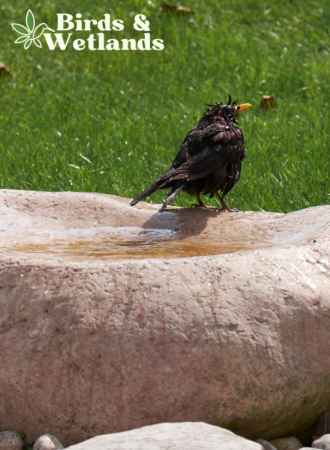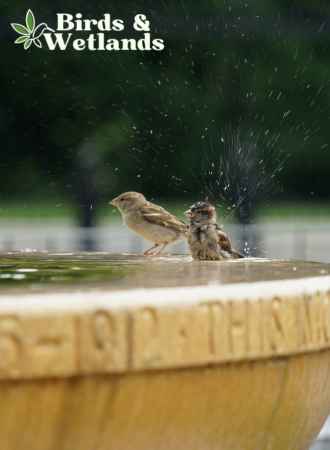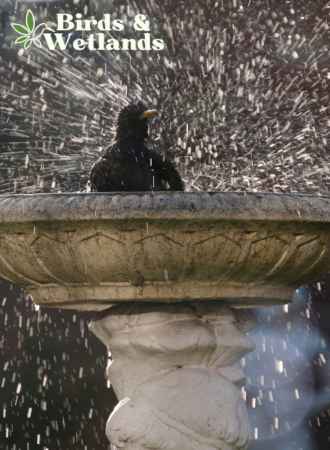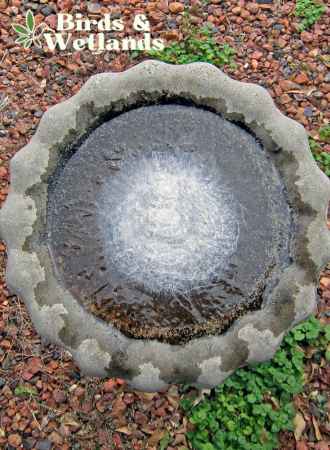There is something truly magical about observing birds in their natural habitats. Whether you live in a bustling city or the suburbs, creating a bird-friendly environment in your backyard can be a great way to attract a diverse range of bird species.
One of the most effective ways to attract birds to your yard is by providing a bird bath.
Key Takeaways on Attracting Birds to Use a Bird Bath
What time of day do birds use bird baths?

Most birds use bird bath during the day, with the most common times being in the morning and late afternoon. This schedule is because these are the times when birds are most active and need water to drink and bathe in.
In the morning, birds typically search for food and water after a night’s rest. As such, they may use bird baths to rehydrate and clean themselves before starting their day.
In the late afternoon, birds may use bird baths to cool off and clean themselves after a long day of flying and foraging.
It’s worth noting that the specific time of day that birds use bird baths can vary depending on factors such as temperature, weather conditions, and different species of birds. For example, birds may be more likely to use bird baths during hot summer days when they need to cool down.
Where to put bird baths to attract birds?
To attract birds to a bird bath, proper placement is important. Here are some tips on where to place bird baths to attract birds:
- Choose a visible location. Place the bird bath in a spot where birds can easily see it and have easy access. This bird bath placement will help them locate and feel safe using the water source.
- Keep it close to cover. Birds will feel more secure if the bird bath is placed near trees or shrubs, where they can quickly fly for cover if they feel threatened.
- Provide a nearby food source. Placing bird feeders or planting native plants nearby can provide birds with food and encourage them to use the bird bath.
- Choose a safe location. Make sure the bird bath is placed in an area where birds feel safe.
Should bird baths be in sun or shade?

A bird bath should ideally be placed in a shaded location rather than in direct sunlight. While it’s true that birds need sunlight to help synthesize vitamin D, having a bird bath in direct sunlight can cause the water to become too hot for birds to use comfortably, especially during the hot summer months. Putting it in the shade can keep the water cooler and fresher.
Direct sunlight can cause algae growth in the bird bath. Algae can make the water murky and potentially harmful to birds. It can also clog up the water fountain or other moving parts of the bird bath and invites insects to lay eggs.
Therefore, it’s best to place the bird bath in a shaded location, such as under a tree or on a covered patio, to keep the water cool and discourage algae growth.
It’s also important to keep the bird bath clean and to change the water frequently, especially during hot weather, to ensure that the water remains fresh and inviting to birds.
How long does it take birds to find a bird bath?
The amount of time it takes for birds to find a bird bath can vary depending on several factors, including the location of the bird bath, the birds in the area, and the availability of other sources of moving water nearby.
In some cases, birds may find a newly installed bird bath within a matter of hours or days, especially if the bird bath is located in an area with high bird activity or if the bird bath is visible and easily accessible.
However, in other cases, it may take several weeks or even months for birds to discover a new bird bath, especially if it is located in an area with low bird activity.
To help birds find a newly installed bird bath more quickly, it’s important to choose a visible location for the bird bath, place it near trees or shrubs for cover, and keep it clean and fresh with regular water changes. It may also help to provide a nearby food source, such as a bird feeder or native plants, to attract birds to the area.
Once birds have found a bird bath and established it as a reliable water source, they will likely return to it regularly, especially if it is well-maintained and easily accessible.
Why aren’t birds coming to my bird bath?

If birds are not coming to your bird bath, there may be several reasons. Here are some common reasons why birds may be avoiding your bird bath:
Location
Birds may be unable to find the bird bath if it is hidden or in a location that is not easily visible. If the bird bath is too close to busy roads or other sources of noise and disturbance, other birds may feel too stressed to use it.
Water quality
Many birds are attracted to clean bird bath and they avoid filthy water. Make sure to clean the bird bath regularly and add fresh water every few days.
Depth

Birds prefer shallow water that they can comfortably stand in. If your birdbath is too deep, birds may not feel safe using it.
Design
The design of the bird bath may be unappealing to local birds. For example, the sides of the birdbath may be too steep or slippery, making it difficult for birds to perch or drink.
Availability of other water sources

If other water sources are nearby, such as streams, ponds, or puddles, bathing birds may prefer to use those instead of the bird bath.
Should you put stones in a bird bath?
Yes, adding rocks to a bird bath can benefit both the birds and the bird bath itself.
- Improved stability: Placing rocks in the bottom of the birdbath can help to improve its stability and prevent it from tipping over or wobbling.
- Better grip: Rocks or pea gravel can also provide a better grip for birds to stand on while drinking or bathing, especially if the bottom of the birdbath is slippery.
- Attraction of small animals: Rocks can also help to attract insects to the birdbath, which can attract more birds to your yard.
- Aesthetic appeal: Putting rocks to the birdbath has an added benefit of making it more visually appealing and natural-looking in your garden.
When adding rocks to a birdbath, it’s important to choose rocks that are smooth and clean, without sharp edges or protrusions that could harm backyard birds. It’s also important to clean the rocks regularly to prevent the buildup of dirt, or other debris.
Additional Tips To Entice Birds To Use Your Birdbath

To ensure that your feathered friends have access to clean water year round especially during freezing weather conditions, it’s recommended to install a heated bird bath. This will provide a source of warmth when the water freezes and as temperature drops in winter.
Hugeneroy Heated Bird Bath
The Perfect Winter Helper
The hugeneroy Heated Bird Bath is a much-needed winter survival aid for our feathered friends, offering thermostatically controlled heat, durable construction, and energy-efficient operation.
- Winter-Friendly: Designed specifically for colder seasons, this bird bath maintains water just above freezing point, providing a constant source of liquid water for birds, even in heavy snowfall.
- Energy Efficient: With a built-in 120V 60W high-quality heating element, the birdbath heats up only when necessary, ensuring minimum energy consumption.
- Superior Material: Unlike ceramic or concrete alternatives that may crack under heat, this bird bath is made from quality, BPA-free plastic that withstands heating without generating harmful substances.
- Safety First: Featuring a thermostatically controlled operation, the bird bath automatically cuts off electricity when the water is dry, ensuring safety for the birds and other backyard animals.
- Attractive to Birds: The off-white bird bath blends in with the natural environment, attracting more birds to your backyard. It can also be adorned with colourful stones to make birds feel more secure and enhance your garden aesthetics.
- Keep your bird bath close to the ground level.
- You can make your own birdbath out of an old frying pan or a trashcan lid with the same water feature as those bought from stores.
- Keep water fresh by replenishing water supply regularly, especially during the hottest days.
- The best birdbaths have water features such as a recirculating pump, a fountain alternative in the form of a water wiggler or dipper, and outfitted with a ground fault interrupter, or GFI to prevent electrical shock.
- Put a shallow bath because small birds will not use bath in deep water.



